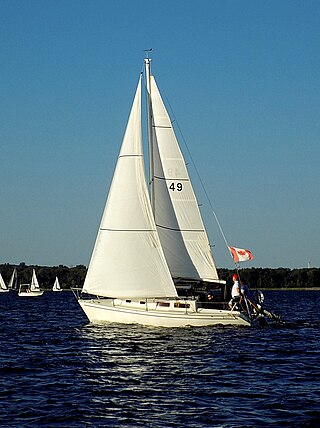The Santana 22 is an American trailerable sailboat, that was designed by Gary Mull and first built in 1966.

The Schock 23 is an American trailerable sailboat, that was designed by Steven Schock, with a wing keel designed by Finnish engineer Reijo Salminen and first built in 1987.
The Balboa 24 is an American trailerable sailboat that was designed by W. Shad Turner and William Downing as a racer-cruiser and first built in 1981.
The Balboa 22 is an American trailerable sailboat that was designed by W. Shad Turner and William M. Downing as a cruiser and first built in 1977.
The Cal 22 is an American trailerable sailboat that was designed by C. R. Hunt Associates as a cruiser and first built in 1984.
The Chrysler 20 is an American trailerable sailboat that was designed by Halsey Herreshoff and first built in 1977.
The Dufour 24 is a French trailerable sailboat that was designed by Michel Dufour and first built in 1975.
The Ensenada 20 is an American trailerable sailboat that was designed by Lyle C. Hess as a cruiser and first built in 1972.
The Lancer 25 is an American trailerable sailboat that was designed by W. Shad Turner as a cruiser and first built in 1975.
The Nimble 25 Arctic, also called just the Nimble 25, is an American trailerable sailboat that was designed by Ted Brewer as a cruiser and first built in 1988.
The Santana 21 is an American trailerable sailboat that was designed by Seymour Paul as a lightweight racer-cruiser and first built in 1969.
The Santana 23 is a lightweight, 23-foot 4-inch sailboat that was designed by W. Shad Turner and manufactured by W. D. Schock Corp as a "high performance racer" and trailerable cruiser. It was first built in 1978 and remained in production through 1987, with a total of 194 units produced, though the hull was brought back in 1993 as the Santana 2023. It was produced through 1984 as the Santana 23 "D" model, commonly called the Santana 23D, with a retractable, verticle, daggerboard keel similar to racing dinghys, with a remaining 50 produced through 1987 with a traditional keel, called the Santana 23K. The hull was also used to inspire the Wavelength 24 also by Schrock, and supposedly "many other models."
The Santana 25 is an American trailerable sailboat that was designed by W. Shad Turner as an International Offshore Rule Quarter Ton class racer and first built in 1973. The boat was Turner's first design.
The Santana 2023 is a family of American trailerable sailboats that was designed by Steve Schock, with models for racing and cruising, first built in 1993.

The Wavelength 24 is an American trailerable sailboat that was designed by Paul Lindenberg as a Midget Ocean Racing Club (MORC) racer and first built in 1982.
The Windrose 18 is an American trailerable sailboat that was designed by W. Shad Turner as a cruiser and first built in 1974.
The Windrose 24 is an American trailerable sailboat that was designed by W. Shad Turner as a cruiser and first built in 1974.
The Santana 28 is an American sailboat that was designed by W. Shad Turner as a cruiser and first built in 1976.
The Santana 525 is an American sailboat that was designed by W. Shad Turner as a one design and International Offshore Rule Quarter Ton class racer-cruiser and first built in 1977.
The Schock 35 is an American sailboat that was designed by W. Shad Turner as a racer-cruiser and first built in 1984.




